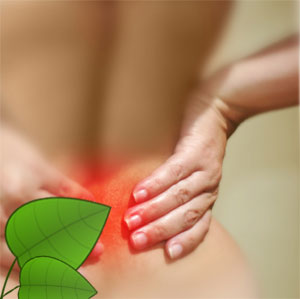Intervertebral discs are tough fibrous pads joining each of the spinal vertebrae i.e. back bones. Each inter-vertebral disc is composed of a tough outer layer of ligament, the annulus fibrosis and a soft gelatinous core. The structure act as a shock absorber to cushion the vertebrae during the movements of the spine and to minimize harshness when jumping or running.
Causes of Intervertebral disc prolapse
Although a prolapsed disc may sometimes be caused by a sudden strenuous action, it usually develops gradually following repeated overuse of certain tasks and sporting activities. Other causes include stress fractures and also genetics also play a part in the probability of a slipped disc occurrence.
Any disc in the entire spine can prolapse or burst, the most common ones to which this happens are the lowest two, which is between the fourth and fifth lumbar vertebrae and between the fifth lumbar and the top of the sacrum, as the stresses experienced by the spine are the greatest at these levels.
Because the discs themselves have virtually no nerve supply it is only when a disc prolapses and presses onto a nerve or some other vulnerable part of the spine, the pain can be noticed. The pain of a prolapsed disc tends to be deep, dull and persistent and it may radiate into all sorts of unexpected places. For example, a prolapsed disc in the lower back may produce pain in several places such as the buttocks, hip, groin or legs. Some people find that these pains are worse if they bend in one particular way. Others find that their pains become unbearable if they stand straight. And it isn’t uncommon for people to complain that their pain is worse when they sneeze, cough or laugh.
Once the disc bursts then it is permanently damaged. After which that disc will never be totally normal again. It’s resistance to further injury is considerably reduced and anyone who has had a burst intervertebral disc is always at risk of further episodes of acute pain.
 Naturopathic Treatment
Naturopathic Treatment
Bed rest and Fasting: The first treatment for a prolapsed disc is a short period of rest with true fasting and natural pain killers followed by physical therapy. The rationale for bed rest relates to the reduction in both mechanical pain and intra-discal pressure in the supine position. Most people who follow these treatments will recover and return to their normal activities very soon. The period of rest may extend from 2 days to 40 days depending on the severity of the prolapse.
While on bed rest, if total fasting is also observed by drinking only water or some coconut water, body vitality gets ample opportunity to attend to the healing of the damage. Period of bed rest is the best time to fast as the patient is already on physical rest. It further provides physiological rest. If we care to give sensory and mental rest the healing takes place very fast and thus the pain relief.
Enema: It is advantageous as the regular bowel movements will be poor due to the lack of physical activity. It is also advocated when the intestines are bloated, which will indirectly aggravate the pain.
Manipulative therapies: General Massage is strictly contraindicated on the days of severe pain as it may lead to further bruising of the disc. Only stroking movement for relief of pain can be given Later, when pain subsides certain other therapeutic manipulations by experts can be performed. Once the pain is totally relieved, to strengthen the disc and the surrounding structures massage will be helpful. Regular massage over the region below the area of prolapse will provide relief over the pain which will be persistent along the course of the affected nerve. Following massage heat treatment in the form of poultice, fomentation will provide more relief. Too much heat during the active painful period is also damaging to the disc. Due to severity of pain patients ask to perform even hard blows over the back, which is highly dangerous.
Physical therapy: Controlled movements/ mobilization/ special exercises/ traction will also be helpful. Traction can relax the tonic hip muscles, correct the lateral bending and enlarge the intervertebral space there by facilitating the replacement of intervertebral disc.
Yoga: Unless the muscle retains its flexibility which keeps the inter-vertebral spaces apart preventing compression of the disc, the problem will recur. Thus to regain or improve the flexibility the best tool is Yoga. After the period of active pain/bed rest, pavana muktasana without raising head and tiger stretch (Marjari asana) with dead slow up and bending (curving) of lumbar part shall be two postures that can help. It is the mechanical way of treating the condition. Later, a routine practice of merudandasana, setubandasana, bhujangasana, salabasana and vakrasana will not only improve in due course of time the flexibility but will also increase the bone strength.
Diet is crucial in relieving the back pain and recurrence of IVDP in overweight patients. A strict diet regimen excluding all the synthetic foods high in carbohydrates and fat food and consuming foods rich in fibers will help to reduce the weight. Further the advantage is there will be proper bowel movements with this type of diet.
Acupuncture : Acupuncture is outstandingly effective in controlling the pain both in the acute and chronic conditions.
Hydrotherapy /Mud Therapy
Note: The pressure on the intervertebral disc is increased during sitting and bending postures, as opposed to standing or recumbent positions. This explains the exacerbation of herniated disc symptoms when the patient is in the sitting position.
